|
|
Samwell RUGGEDBOOK SR800
Powerful, rugged tablet computer with 10.4-inch display and dual digitizer
(by Conrad H. Blickenstorfer, photography by Carol Cotton -- view PDF version)
Taiwan-based Samwell Group is a global technology solutions provider concentrating on the convergence of Internet, computing, and telecom technologies and software applications. "RUGGEDBOOK" is Samwell's brand name for their complete line of semi-rugged and fully rugged mobile computing products that include rugged convertible notebooks, ultra-mobile PCs, and the SR800 rugged Tablet PC shown here.
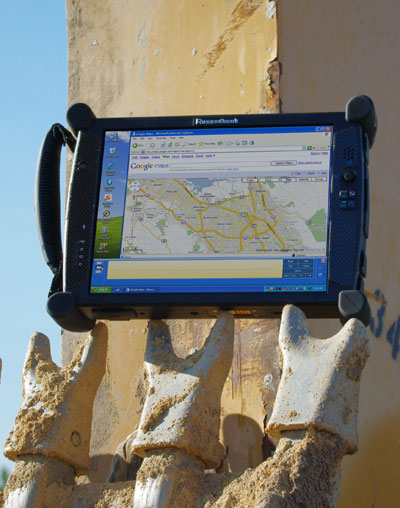 Overall, the RUGGEDBOOK SR800 is a rugged Tablet PC, the kind of machine you use for jobs that require full Windows computing power on the go, as in walking around with the machine, or using it in a vehicle where it can be docked and then quickly removed when it is needed outside. Overall, the RUGGEDBOOK SR800 is a rugged Tablet PC, the kind of machine you use for jobs that require full Windows computing power on the go, as in walking around with the machine, or using it in a vehicle where it can be docked and then quickly removed when it is needed outside.
Mobile computers like this are usually built to handle the kind of abuse expected in the field. It may get dropped, get banged around a bit, or get rained on. As a result, the SR800 is a very solid machine, and those big rubber bumpers that give it its characteristic and unique look offer a good degree of protection. Overall size of the unit is about 10.5 x 7.5 x 1.75 inches without taking the bumpers into consideration. Our test machine weighed exactly five pounds, including battery, handle and bumpers. That's a bit heavy to carry around all day, but it is in line with comparable devices.
On the technology side, the RUGGEDBOOK SR800 has a frugal Intel Core Duo processor, and our review machine came with two gigabyte of RAM, and a speedy 80GB SATA disk. For connectivity, the SR800 is well equipped for a tablet. There are two standard USB 2.0 ports, a mini-USB jack, an RS232 serial port for legacy peripherals, an RJ11 modem port, an RJ45 LAN port for gigabit Ethernet, audio in and out jacks, and a multi-IO port for the optional cradle. For expansion, there are externally accessible PC Card Type I/II and Compact Flash slots. The display measures 10.4 inches diagonally, which is larger than what most of the competition offers in this class. The SR800 comes with both an active digitizer and a resistive touch screen. An outdoor viewable version of the display is available as an option.
For communication, there is integrated Bluetooth Class II, Version 2.0 with EDR (Enhanced Data Rate) and 802.11a/g/n WiFi. Optionally available via the PC Card slot and internal expansion are GPS as well as GPRS/EDGE/UMTS wireless wide area network functionality.
In addition to pen and touch control, there is a small five-way navigation diamond that also doubles for brightness and volume control duty, a display rotation key, a WiFi/Bluetooth switch, a function hotkey, an ESC key, and the power button. The unit comes with a nicely designed pen that can be tethered so it won't get lost, and has a secure garage on the backside of the computer.
Rugged yet refined
When you open the box the RUGGEDBOOK SR800 comes in and take the computer out, the first impression is that it looks and feels very refined for such a rugged computer. The thick rubber bumpers that in pictures look sort of pasted on feel very much like an integral part of the unit, and it instantly becomes clear that they not only offer a good deal of extra protection, but also act as "feet" when you sit the unit down, either on its side or flat on its back. It's been pointed out to me recently that this is actually a much-requested feature in field computers.
As is, the bumpers of the SR800 will not make it stand on its own when you place it on its side, but they are great for leaning the computer against something and then using it at almost any angle. The rubber bumpers keep it from slipping and falling. Another purpose of them is making sure the fan can work properly when the unit is sitting on its back.
The fit and finish is surprisingly elegant and subdued for a rough and tough machine designed to be used under the worst conditions out there. The matte black paint has a very fine powdercoat finish to it. The bumpers fit perfectly, with no gaps at all. The hardware button placement is ergonomically absolutely prefect, and the buttons themselves are small and very precise, like on a PDA. The buttons and various control lights are sitting in decorative insets with a faux carbon fiber finish that nicely match the design, though the faux fiber finish probably wouldn't have been our choice.
The protective rubber flaps that cover the ports on three sides of the machine are soft and flexible enough to be handled easily, unlike some of the inflexible ones we've seen and wrestled with on other machines. They are also designed and manufactured very precisely and they fit perfectly. That's good as I get a bit concerned every time I see rubber plugs serve not only as physical barriers and protection of the connectors, but apparently also as the sole seal between outside and inside of the machine.
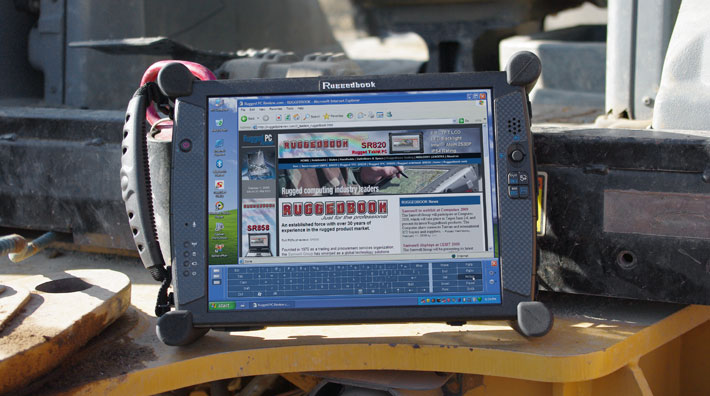
The display takes up most of the front surface. The bezel leaves exactly enough space for your thumbs and the soft inside part of the base of your thumb to the left and right of the display, but no more. I like machines that are no larger than they need to be to accommodate their display, and the RUGGEDBOOK SR800 is one of them.
The handle that is such a prominent part of this machine when you look at it on pictures is actually a canvas/mesh belt with a plastic/rubber grip part on it. It is not rigid and doesn't get in the way. If it is, it can easily be removed by undoing four screws. It cannot be attached onto another side of the device, however. If some sort of a handheld grip is desired, the RUGGEDBOOK SR800 has an attachment system on its back that allows using a handgrip via four screws.
The display itself not only takes up most of the front real estate of the unit and thus gives the device a purposeful, contemporary look, the matte, glarefree display surface is also completely smooth and is only moderately prone to fingerprints.
Controls and ports
Below you can see what the RUGGEDBOOK SR800 looks like from the front and from all four sides. Note that all ports are sealed with soft rubber plugs that are attached to the computer with small Philips screws so that they can easily be replaced should they ever break or rip off. The four large rubber bumpers, likewise, can easily be replaced.
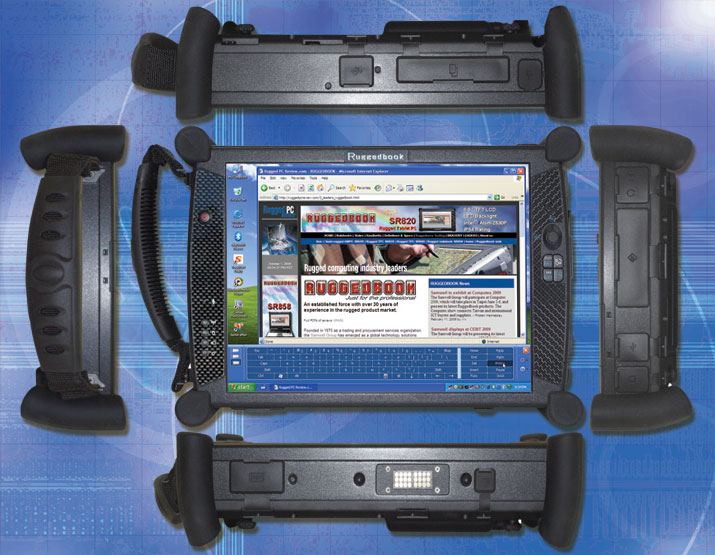
Going around the unit:
- On the bottom are the surface-mount cradle contacts as well as a power plug and a standard DB9 RS232 serial port connector that can both be sealed with separate rubber plugs.
- The left side does not have any connectors or other interfaces.
- On the right side are the modem port, the microphone and headphone jacks, the two USB ports, and the Compact Flash slot.
- The top of the unit features the PC Card slot, the RJ45 LAN port, and the mini-USB port.
- The front side has—in addition to the screen, navigation stick and button controls—the internal microphone on the left, the speaker right above the nav pad, and four LED indicator lights for power, charge status, disk activity and wireless radio status. They are quite bright and I wish one could tone them down a bit.
Below the navigation stick are four small push buttons with small white and blue labels on them. One of them is the function button that you hold down to access the secondary function of the other buttons. The functions are:
- Security Button -- Labeled SAS for "Secure Attention Sequence," this brings up the Windows Task Manager and its help function.
- Wireless Button -- This cycles through all wireless off, WiFi on, Bluetooth on, both on. This can be a bit confusing.
- Screen Rotate Button -- Toggles between landscape and portrait.
Interior access
The picture to the right shows the exposed backside of the RUGGEDBOOK SR800. The two backplate covers are securely held in place by small Philips screws and both have O-ring style pressure seals. These seals form the barrier between inside and outside. Even a small scratch or something caught between the seal and the surface it presses against can mean leaks, so upon battery replacement or servicing, make sure the seals are intact and the covers are screwed back on tightly.
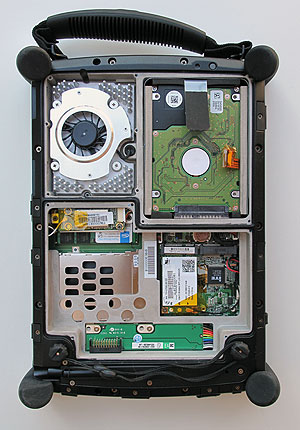 The impression you get once the covers are removed is that the RUGGEDBOOK SR800 is a very well designed unit. Everything is neatly laid out, well designed, and very sturdy. Nothing rattles around and nothing is loose. This is as it should be in a rugged computer The impression you get once the covers are removed is that the RUGGEDBOOK SR800 is a very well designed unit. Everything is neatly laid out, well designed, and very sturdy. Nothing rattles around and nothing is loose. This is as it should be in a rugged computer
In the picture to the right, you can see a number of expansion modules. There are two PCI Express slots, one of them taken up by an Intel 4965AGN WiFi module, the other one available for expansion. Modules are held in place by two screws so that they cannot come loose (this can be a concern with rugged computers). The Intel 4965AGN WiFi module can accommodate multiple antennae and is therefore ready to support MIMO (multiple input, multiple output) technology. In our review unit, only one of the module's antenna ports was used.
A single SODIMM memory slot is accessible, and memory modules are easily replaceable.
The hard disk (upper right in the picture) has its own shock-absorbing metal caddy (see below) where it sits very nicely protected by thick pads of precisely cut and very dense rubber foam. 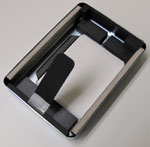 The caddy is designed so that it securely fits into the chassis and cannot move around. There is also what appears either a heater unit or a temperature sensor. The disk in our tester was a 80GB Hitachi 5,400rpm SATA model. The caddy is designed so that it securely fits into the chassis and cannot move around. There is also what appears either a heater unit or a temperature sensor. The disk in our tester was a 80GB Hitachi 5,400rpm SATA model.
Upon initial examination, users may wonder what those prominent fan slots are doing in a supposedly sealed unit. Well, there is a generously-sized fan (see upper left), but the fan/heat exchanger compartment is actually outside the computer. Water cannot enter the interior of the machine through the fan compartment, and the fan itself can actually run submerged, so it remains unaffected even when exposed to water.
The backside of the SR800 also has four VESA-standard screw holes. These can be used for a variety of mounting purposes, and also as anchors for an optional handstrap.
Performance
In a desktop computer, performance is simply a cost issue and power consumption hardly matters because the system is plugged into the wall. In mobile systems, it's a careful balance between speed, weight and battery life. Mobile computers need to be quick and responsive, and have enough punch to power through the type of work they are assigned to do. Since mobile computers generally run the same operating systems and the same applications as desktops, mobile computing designers are facing a very difficult job; they need to provide enough performance for the machine to run acceptably fast, but without adding too much weight, generating too much heat, or consuming too much battery power. That is not an easy task, and one that requires intelligent compromises.
How did the SR800's designers approach the job? They used a mature solution in the form of the Intel Core Duo U2500 CPU, a member of the processor family formerly known as Yonah. The U2500 has been available since 2006, and Intel guarantees a manufacturing availability of 7+ years. It's an efficient, low-voltage processor with a thermal design power (TDP) rating of just 10 watts, which is not even a third that of most notebook processors. Thermal design power, by the way, is the maximum amount of power a computer's cooling system needs to dissipate and is used by Intel as a measure of power efficiency. The U2500 is also a processor successfully used in several competing slate computer products.
We ran Passmark Software's PerformanceTest 6.1 that runs about 30 tests covering CPU, 2D graphics, 3D graphics, memory, and disk and then computes scores for each category and an overall PassMark score. For comparison, we included the benchmarks of slate computers whose processors bracket the U2500. The Motion Computing J3400 tablet uses the 1.4GHz ultra-low voltage Core 2 Duo SU9400, and the rugged Winmate IA80 slate is built around the popular Intel Atom N270.
|
PERFORMANCE COMPARISON
|
Samwell
|
GD-Itronix
|
Motion
|
Winmate
|
|
Model
|
RUGGEDBOOK SR800
|
Duo-Touch II
|
J3400
|
IA80
|
|
Processor
|
Intel Core Duo U2500
|
Intel Core Duo U2500
|
Intel Core 2 Duo SU9400
|
Intel Atom N270
|
|
CPU Speed
|
1.2GHz
|
1.2GHz
|
1.4GHz
|
1.6GHz
|
|
Thermal Design Power (TDP)
|
10.0 watts
|
10.0 watts
|
10.0 watts
|
2.5 watts
|
|
CPU Mark
|
642.1
|
545.0
|
834.9
|
162.7
|
|
2D Graphics Mark
|
140.9
|
164.4
|
172.9
|
212.3
|
|
Memory Mark
|
175.5
|
240.6
|
347.1
|
224.0
|
|
Disk Mark
|
351.1
|
318.8
|
552.5
|
382.5
|
|
3D Graphics Mark
|
103.1
|
101.4
|
105.3
|
81.3
|
|
Overall PassMark
|
307.3
|
312.6
|
435.2
|
200,2
|
Not surprisingly, the SR800 scores roughly the same as the highly regarded General Dynamics Itronix Duo-Touch II. There are differences in the sub-scores where the larger SR800 display probably dragged down the graphics benchmarks but its newer disk outscored the one in the DT-II that we tested in 2007. As expected, the Core 2 Duo-powered Motion and the Atom-powered machine bracket the results, showing where the SR800 tablet fits in.
Battery and battery life
The large battery pack of the RUGGEDBOOK SR800 fits into the backside of the unit. It sits under a cover that is securely held in place with six Philips screws. Open that and you look right into the inside of the SR800 (as shown in the picture of the backside of the unit further up). 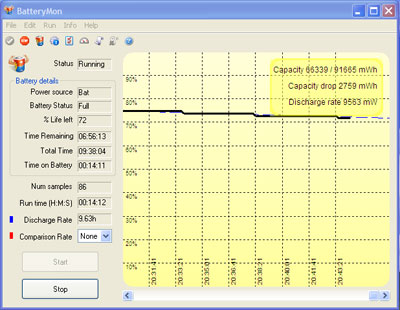 That's why the rigid magnesium cover has a meticulously engineered rubber pressure seal that is glued in place. Make absolutely certain that this seal is intact when you close the cover, and make sure all battery cover screws are accounted for and securely screwed down. You do not want a leak here. That's why the rigid magnesium cover has a meticulously engineered rubber pressure seal that is glued in place. Make absolutely certain that this seal is intact when you close the cover, and make sure all battery cover screws are accounted for and securely screwed down. You do not want a leak here.
Our battery benchmark software, Passmark's BatteryMon, reported a battery capacity of 7540mAH, making for 90.5 watt-hours, considerably more than the 79 watt-hours officially specified. For our BatteryMon testing, we set the screen at about 30% brightness and turned wireless off. That way, power draw is an amazingly low 9.5 watts at that brightness, which makes for a projected battery life of over nine hours! Even at full brightness, the RUGGEDBOOK SR800 only draws about 13 watts, still good enough for seven hours. Even if we assume that BatteryMon is wrong and the official 79 watt-hours is accurate, the SR800 would still run between six and eight hours on a charge.
The very low battery draw of this machine proves another point: you don't necessarily need an Atom processor to get great battery life. Properly implemented, a full-power machine like the RUGGEDBOOK SR800, using a Core Duo processor, can run almost as efficiently.
Ruggedness
The RUGGEDBOOK SR800 is definitely a rugged device, from its super-tough magnesium housing to the large shock-absorbing rubber bumpers. 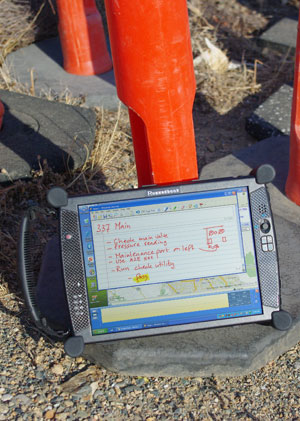 The latter, especially, afford an extra degree of protection should the machine get dropped, and that includes protection against unsightly scratches and scuffs as well as keeping the machine operational. This comes at the expense of quite a bit of extra bulk that the bumpers add to the machine. If that's a issue, you can remove the bumpers and the RUGGEDBOOK SR800 is still a rugged machine. The latter, especially, afford an extra degree of protection should the machine get dropped, and that includes protection against unsightly scratches and scuffs as well as keeping the machine operational. This comes at the expense of quite a bit of extra bulk that the bumpers add to the machine. If that's a issue, you can remove the bumpers and the RUGGEDBOOK SR800 is still a rugged machine.
As far as ruggedness specs go, this machine has gone through an exhaustive set of ruggedness certification tests, 13 areas in all, by an independent testing laboratory. To summarize the most important results, the RUGGEDBOOK SR800 can operate within a very wide temperature range of -4 to 140 degrees Fahrenheit, which means it can be used in any setting from freezers to deserts.
The computer is sealed to IP54 specifications, which means there won't be any harmful accumulations of dust inside the housing, and the machine is protected against water spray from all directions. The water resistance was tested according to the method mandated in MIL-STD-810F, Method 506.4, Procedure I, which is meant to test resistance to rain and blowing rain from all directions.
The machine was also successfully tested in accordance with MIL-STD-810F for thermal shock, vibration, humidity, altitude, storage temperature, and more.
One caveat here is that effective sealing entirely relies on careful use of the protective rubber plugs. There is a total of nine of them, and some (like the two card slot plugs) are the sole barrier between inside and outside of the computer. That's a potential weak spot of this design and we'd prefer to see more protection in areas where a single forgotten plug may cause potentially incapacitating leaks.
Touch and active digitizer
Since tablet computers do not have integrated keyboards, they heavily rely on digitizers and touch screens. Depending on the intended application, a tablet may use a finger/stylus operated touch screen, or an active electromagnetic digitizer. A number of tablet products use dual input systems with both a touch screen and a digitizer so that users can switch, or the system switches automatically. With the RUGGEDBOOK SR800, Samwell offers both touchscreen and digitizer versions. Our review unit came with a Wacom electromagnetic digitizer a well as touchscreen functionality. There is no auto-sensing or any other software method to switching between the modes. Instead, there is a small recessed button on the backside of the computer that toggles between the two modes.
Calibration and configuration of the Wacom digitizer is done through the standard Windows Tablet and Pen Settings control panel. The touchscreen has a separate, elaborate calibration and configuration utility. The screen shots below show some of the TouchSet configuration screens:
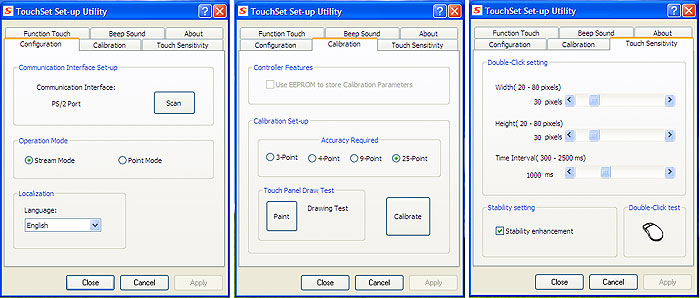
We particularly appreciated being able to do a 25-point calibration, which makes for very precise operation. 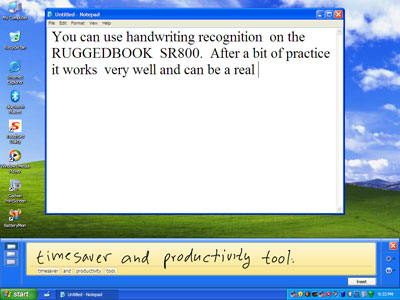 You can also set the width and height of the area that responds to touch. This lets you fine-tune sensitivity and optimize it for touch with a finger or with a stylus. That can make a big difference in custom applications. For use with applications that require audio feedback, you can configure the system to issue a beep when you touch down or terminate the touch, or both. You can even set the frequency of the tone and the duration. This may not seem important, but it can be, depending on the application. It is good to have those configuration capabilities.
You can also set the width and height of the area that responds to touch. This lets you fine-tune sensitivity and optimize it for touch with a finger or with a stylus. That can make a big difference in custom applications. For use with applications that require audio feedback, you can configure the system to issue a beep when you touch down or terminate the touch, or both. You can even set the frequency of the tone and the duration. This may not seem important, but it can be, depending on the application. It is good to have those configuration capabilities.
The touch screen itself is very quick and accurate. Those using ink applications such as Windows Journal will find it easy to draw, doodle and sketch. especially in digitizer mode. Handwriting recognition also works very well, via the Microsoft Tablet PC Input Panel. The example to the right shows the panel in free form mode, writing into NotePad. You can use recognition in virtually all applications, though it is better suited for some than for others.
We really appreciate having both an active digitizer and a touch screen in the SR800. Each has its different strengths and uses, and being able to switch between the two modes greatly adds to the usefulness of this rugged tablet computer.
Summary
The RUGGEDBOOK SR800 is a compact rugged Tablet PC that offers a good balance between performance, features, ruggedness, portability, and battery life. Its 10.4-inch display is larger and offers higher resolution than that of most machines in its class.
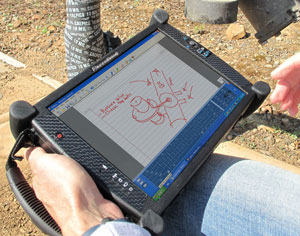 The computer's 1.2GHz Intel Core Duo U2500 processor is an industry workhorse that provides adequate performance. Yet, despite getting full Intel Core Duo processing power, the RUGGEDBOOK SR800 can run as long as six to eight hours on a single charge thanks to excellent power management and a large 80 watt-hour battery.
The computer's 1.2GHz Intel Core Duo U2500 processor is an industry workhorse that provides adequate performance. Yet, despite getting full Intel Core Duo processing power, the RUGGEDBOOK SR800 can run as long as six to eight hours on a single charge thanks to excellent power management and a large 80 watt-hour battery.
Equipped with a manually switchable dual-mode input system, the RUGGEDBOOK SR800 is equally suited for pen and touch applications. The display is crisp and bright, but for work outdoors we'd definitely recommend going with the optional sunlight-viewable display. The controls are a bit small, especially when used with gloves.
A sturdy magnesium housing, excellent interior design and layout, and thick rubber bumpers on all corners provide ruggedness and good protection. The RUGGEDBOOK SR800 also offers excellent onboard connectivity, but make sure all those rubber plugs are always securely in place so that dust and water won't get inside.
Overall, the RUGGEDBOOK SR800 is an excellent choice for tasks that require full Windows computing power, a reasonably large display with full XGA resolution, good onboard connectivity, ruggedness, and the ability to run for as long as a full shift between charges of its high-capacity battery.
-- Conrad H. Blickenstorfer
|
RUGGEDBOOK SR800 Specifications
|
| Added/changed |
Added 10/2009, updated 11/2010
|
| Type |
Rugged Tablet PC slate
|
| Processor |
1.2GHz Intel Core Duo U2500 w/ 533MHz frontside bus and 2MB L2 cache |
| CPU TDP |
10 watts |
| OS |
Windows XP Tablet PC Edition or Windows Vista |
| Memory |
2GB DDR2 |
| Chipset |
Intel 945GMS |
| Display |
10.4-inch/1024 x 768 pixel TFT (optional sunlight-readable display) |
| Digitizer/Pens |
Dual mode resistive and electromagnetic digitizer |
| Keyboard |
Onscreen keyboard + optional external |
| Storage |
Shock-mounted 2.5-inch 250GB SATA hard drive |
| Slots |
1 PC Card Type I/II, 1 CF Card Type II |
| Housing |
Magnesium alloy |
| Temperature |
-4 to 140F |
| Enclosure Class |
IP54, MIL-STD-810F, Method 506.4, Procedure I, 10 min per axis, 6 axes, 40 PSIG and no less than 4 in/hr |
| Humidity |
MIL-STD-810F, Method 507.4 Procedures I&II |
| Drop |
MIL-STD-810F, Method 516.5, Procedure IV, 26 drops from 3 ft |
| Vibration |
MIL-STD-810F, Method 514.5 Procedures I; ASTM 4169-99,Truck Assurance Level II, Schedule E
|
| Altitude |
MIL-STD-810F, Method 500.4, Procedures I: 15,000 ft |
| Safety |
TBS |
| Regulatory |
TBS |
| Size |
11.2" x 8.2" x 2.4" (with rubber bumpers) |
| Weight |
4.9 lbs. |
| Power |
Li-Ion 11.1V, 7,200mAH, 79.2 watt-hour ("max. 7 hrs") |
| Communication |
802.11a/b/g (Intel WiFi Link 4965AGN), Bluetooth Class 2 v 2.0 with EDR, GPS; optional WWAN (GSM/GPRS/HSDPA/WCDMA) |
| Interface |
2 USB 2.0, 1 mini-USB, gigabit RJ-45, RJ-11, audio in/out, multi-IO port (contact pin with USB/RS232/Power signal) for cradle |
Price |
inquire |
| Contact |
www.ruggedbook.com.tw or info@ruggedbook.com.tw |
|
(copyright 2009 RuggedPCReview.com)
|



